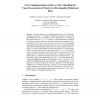Free Online Productivity Tools
i2Speak
i2Symbol
i2OCR
iTex2Img
iWeb2Print
iWeb2Shot
i2Type
iPdf2Split
iPdf2Merge
i2Bopomofo
i2Arabic
i2Style
i2Image
i2PDF
iLatex2Rtf
Sci2ools
ICAISC
2010
Springer
2010
Springer
A New Implementation of the co-VAT Algorithm for Visual Assessment of Clusters in Rectangular Relational Data
This paper presents a new implementation of the co-VAT algorithm. We assume we have an m × n matrix D, where the elements of D are pair-wise dissimilarities between m row objects Or and n column objects Oc. The union of these disjoint sets are (N = m + n) objects O. Clustering tendency assessment is the process by which a data set is analyzed to determine the number(s) of clusters present. In 2007, the co-Visual Assessment of Tendency (co-VAT) algorithm was proposed for rectangular data such as these. co-VAT is a visual approach that addresses four clustering tendency questions: i) How many clusters are in the row objects Or? ii) How many clusters are in the column objects Oc? iii) How many clusters are in the union of the row and column objects Or ∪ Oc? And, iv) How many (co)-clusters are there that contain at least one of each type? co-VAT first imputes pair-wise dissimilarity values among the row objects, the square relational matrix Dr, and the column objects, the square relati...
| Added | 19 Jul 2010 |
| Updated | 19 Jul 2010 |
| Type | Conference |
| Year | 2010 |
| Where | ICAISC |
| Authors | Timothy C. Havens, James C. Bezdek, James M. Keller |
Comments (0)

